An Emergency Multi-use Mobile Powered-Air Purifier Pod for Outdoor Respiratory Protection
Grade 8
Presentation
Problem
Air pollution is “contamination of the indoor or outdoor environment by any chemical, physical or biological agent that modifies the natural characteristics of the atmosphere” (Air Pollution, n.d.). According to Health Canada, “outdoor air pollution is a complex mixture of gas and particles, including: smog, ozone, sulphur oxides, particulate matter (PM), volatile organic compounds (VOCs), and polycyclic aromatic hydrocarbons (PAHs), etc. (H. Canada, 2022). Air pollution is a cause of more than 15000 deaths every year in Canada alone (H. Canada, 2022)
Many sources, such as smoke from wildfires, can cause high air pollution levels and can have a negative impact on people’s health. Especially, seniors, pregnant women, infant & young people, outdoor workers, sick people, etc. are at a higher risk. Wildlife smoke inhalation can cause stroke, heart attack, and premature death (E. and C. C. Canada, 2023)
In 2023, wildfires spread around Canada rapidly which meant that many people were exposed to the thick wildfire smoke. Wildlife firefighters and people escaping wildfires are exposed to the wildfire smoke the most. Wildfires create a challenging environment where fighting the fires and escaping wildfires becomes too difficult. PPE such as masks are difficult to use while fighting the wildfires. Firefighters have to work for a long duration (16 hours per day!) in this challenging environment (Nicholson, 2023). They sleep in tents in the forest full of smoke and are continuously exposed to the pollution (Nicholson, 2023). Due to chronic smoke inhalation in very polluted environments, lung and breast cancers cause more than 85 percent of deaths in firefighter (Nicholson, 2023). There is an urgent need for respiratory protection of these firefighters from air pollution.
I am “extending” the project I had done the previous year which was to create an air purifier for filtering out pollutants from indoor/household air. This year, I will be creating an air purification system which can be used by firefighters for resting and sleeping in a pollution free environment in their tent in the forest under wildfire. This system could be used by anyone who is regularly being exposed to such high air pollution levels or can be used for emergency shelters.
Last year, after CYSF and CWSF, I wanted to improve my air purifier that was based on a Corsi-Rosental box fan filter (Rosenthal, 2020). What is new in this air purifier? This purifier has following additional items: a wet scrubber, zeolite chemical adsorbent, 4x chemical adsorbing media (> 25lbs), 4 HEPA filters, and a powerful blower fan.
Hypothesis:
The use of wet scrubber containing water and sunflower oil will help capture different pollutants (PM, PAHs) in the outdoor polluted air. This wet scrubber when combined with an air purifier containing activated charcoal, zeolite, lava rocks, pre-filters, and 99.95% efficient HEPA filters will effectively filter out remining polluted air.
How it works:
The air pump forces the air into a container with a mixture of water and air. This will dissolve different pollutants in the air such as PM (in water), PAH (in water and oil), etc. Furthermore, this wet-scrubbed air will enter the air purifier where it passes through prefilter, chemical filter (composed of activated charcoal, zeolite, and lava rocks) which will help adsorb existing chemicals in the air. Lastly, the air will pass through the HEPA filters and out through the air outlet and filtered and clean air will be supplied. This purifier can work without wet scrubber as well.
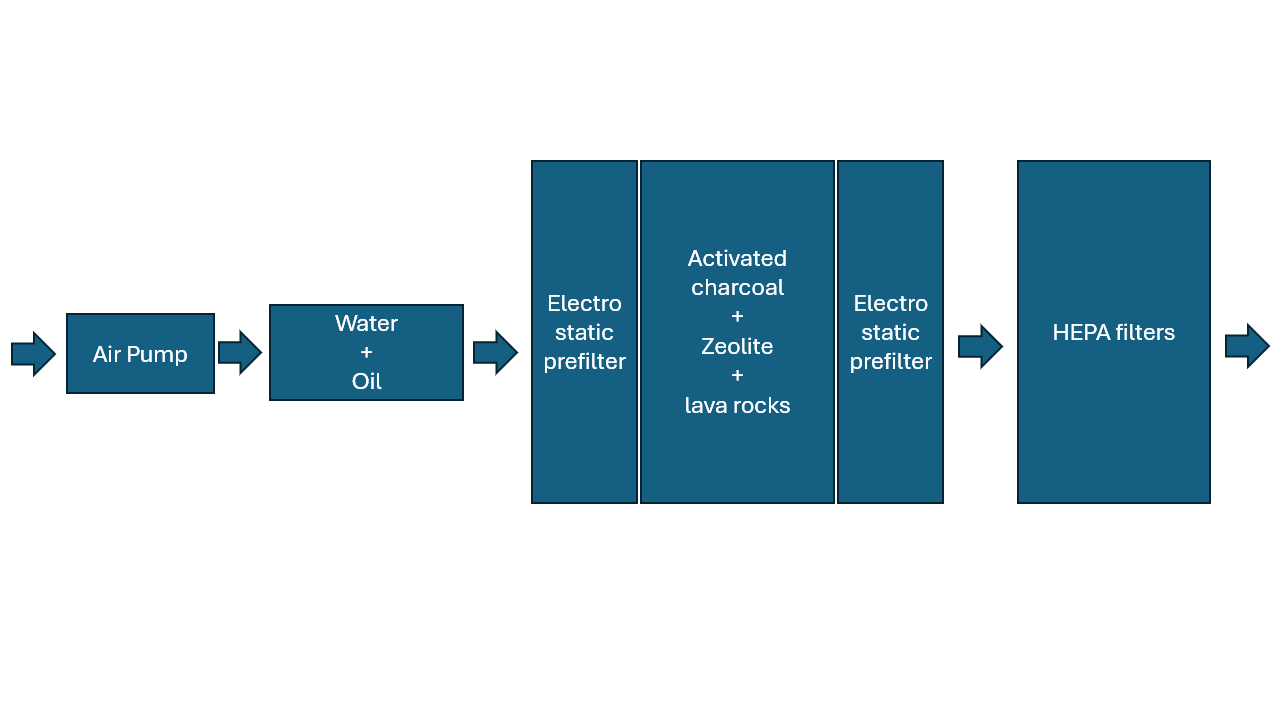
Method
Materials Used:
- 2x8 Lumber
- 3-inch air duct and dust adapters
- Activated Charcoal
- Adhesive tapes
- Air pump for aquarium
- Air quality monitors- Temtop LKC-1000S+ 2nd, Temtop S1, Amazon Smart Air Quality Monitor
- Aluminum HVAC Tape
- aquarium air stones
- Blower fan
- Circulatory fan
- Computer
- Drill
- Electrostatic pre-filter
- Fine metal mesh
- Foam Board
- Formalin 2%
- GraphPad trial software
- Hair spray
- Handsaw
- Hot glue gun and sticks
- Ikea Starkvind Filter 4x
- Incense stick
- Lava Rocks
- N95 mask
- Nails
- Nails and hammer
- Paint Shelter
- Pipes
- Plywood
- Screws
- Shapr 3d software
- Silicone caulk
- Smart phones and their stands
- Staple gun
- Sunflower Oil
- Water
- Water container
- Water containers
- Waterproof tape
- Weatherstripping
- Wood glue
- Wood glue
- Zeolite
Designing air purifier:
I mocked up the design of the whole system (including tent, air purifier, and wet scrubber) on paper, and measurements were written down. Afterwards, I, 3d modeled the air purifier using the Shapr3d program. The 3d modeling of the design was very helpful because I was able to determine how much material was needed to construct the air purifier using the many helpful tools included in this software. The materials were purchased locally and online.
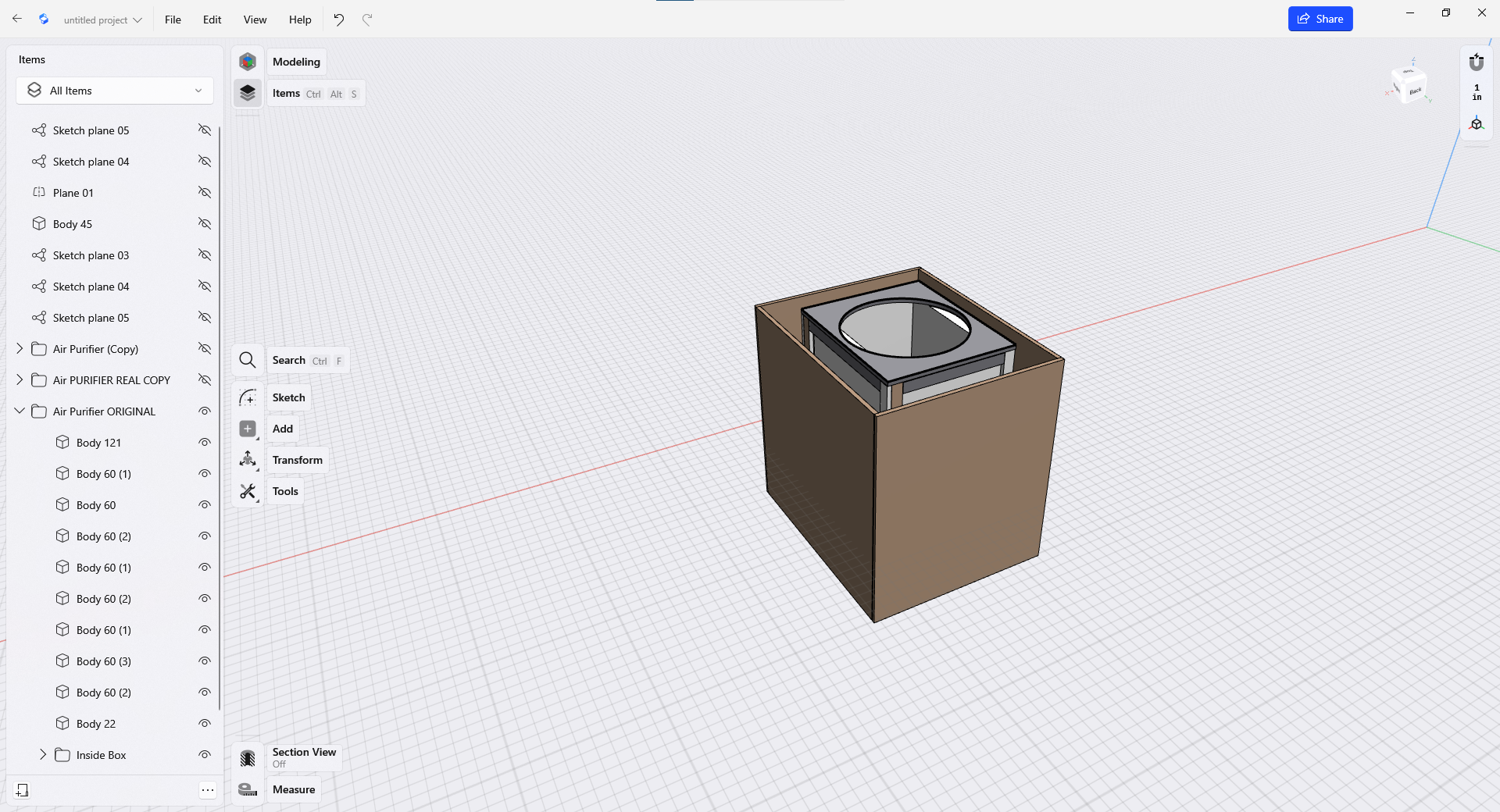
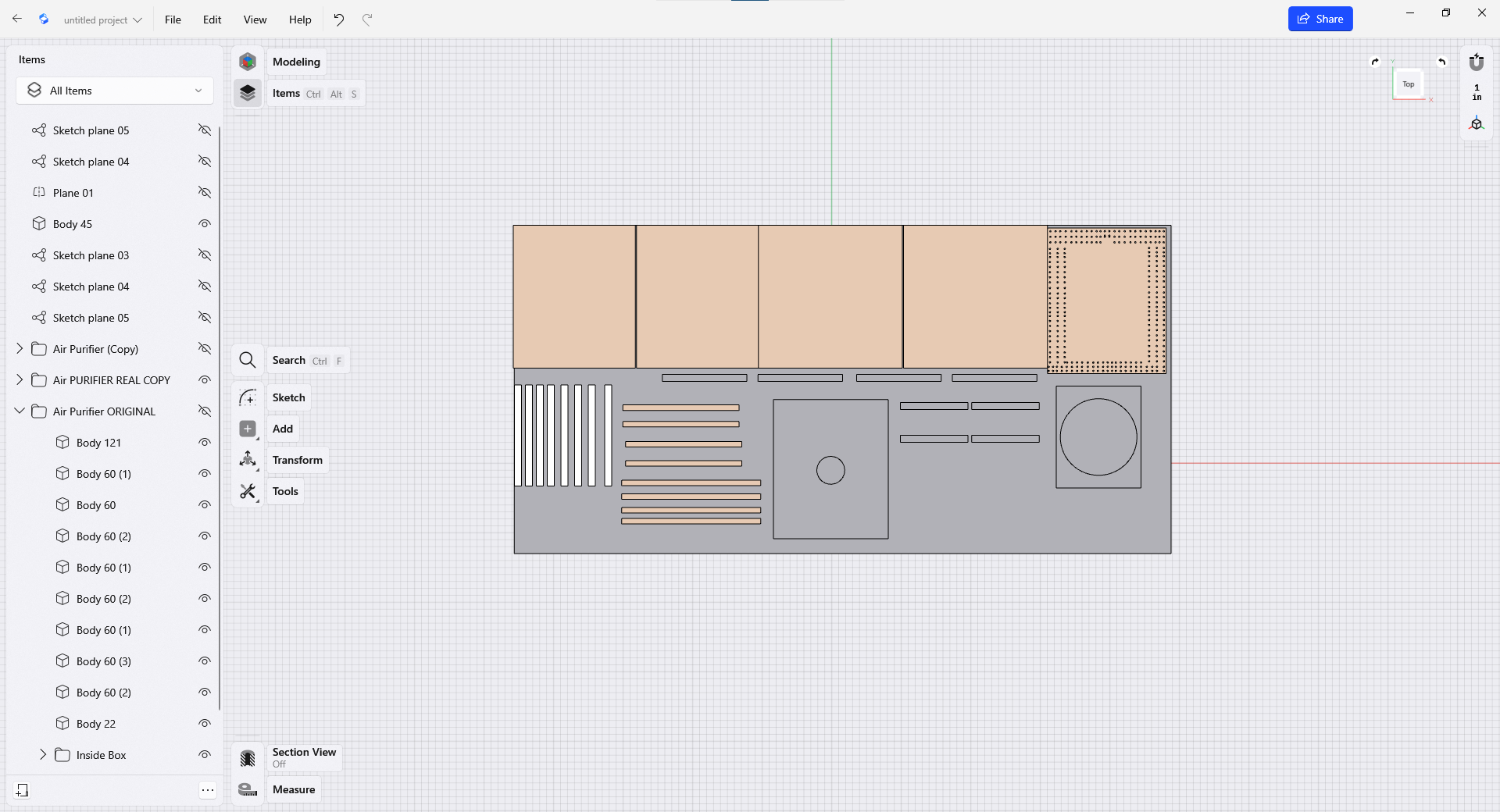
Making of HEPA filter and chemical adsorbing media filter assembly:
I glued 4 Ikea starkvind filters together using hot glue (see photo) and created 4 box panels using a frame I made from using foamboards, and a metal mesh (for support and to prevent media from falling out. I plan on keeping my activated charcoal, zeolite, and lava rocks. I chose these removal media because they adsorb volatile organic compounds (VOCs) and other chemicals from the air very well. I used prefilters on both sides of the metal mesh. With the activated charcoal and zeolite media, I sieved them to remove fine dust which could clog the hepa filters. While sieving the zeolite I wore an n95 mask to prevent inhaling any of the fine dust like particles since there was a lot in the air.
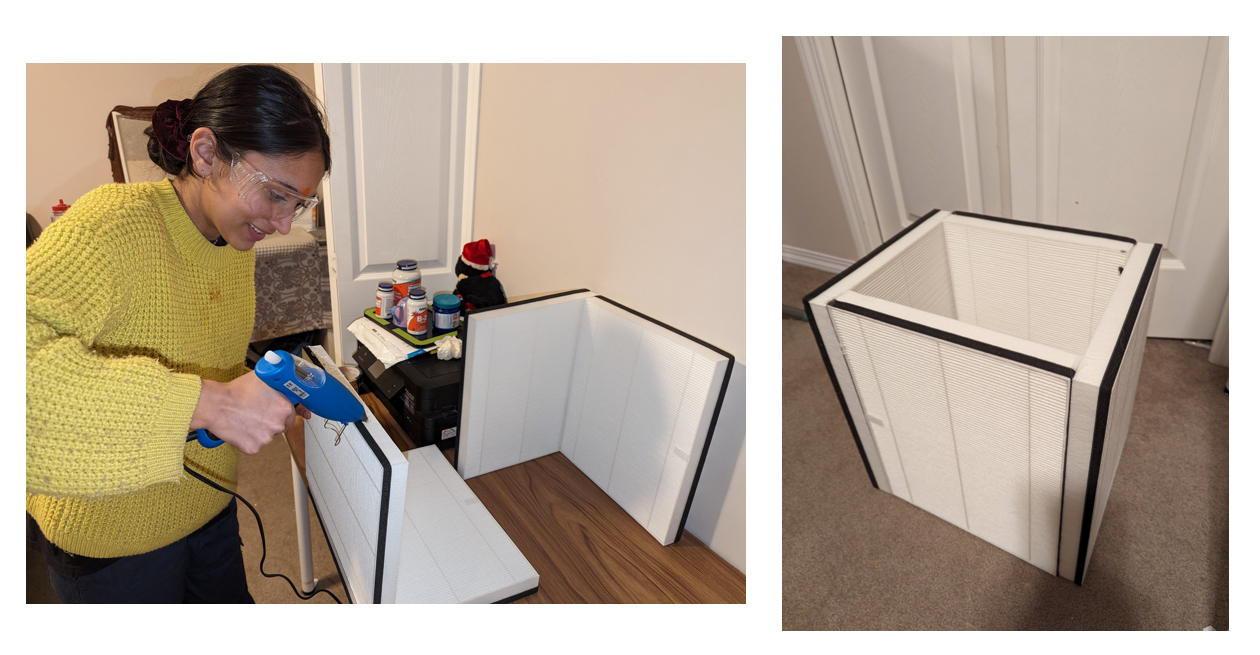
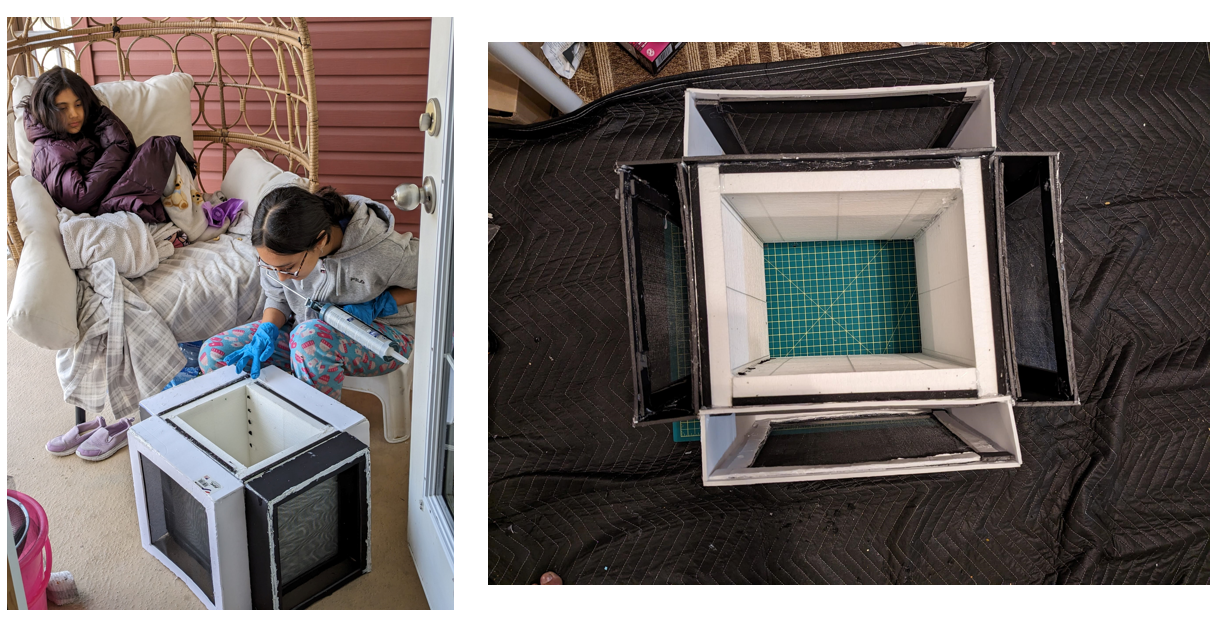
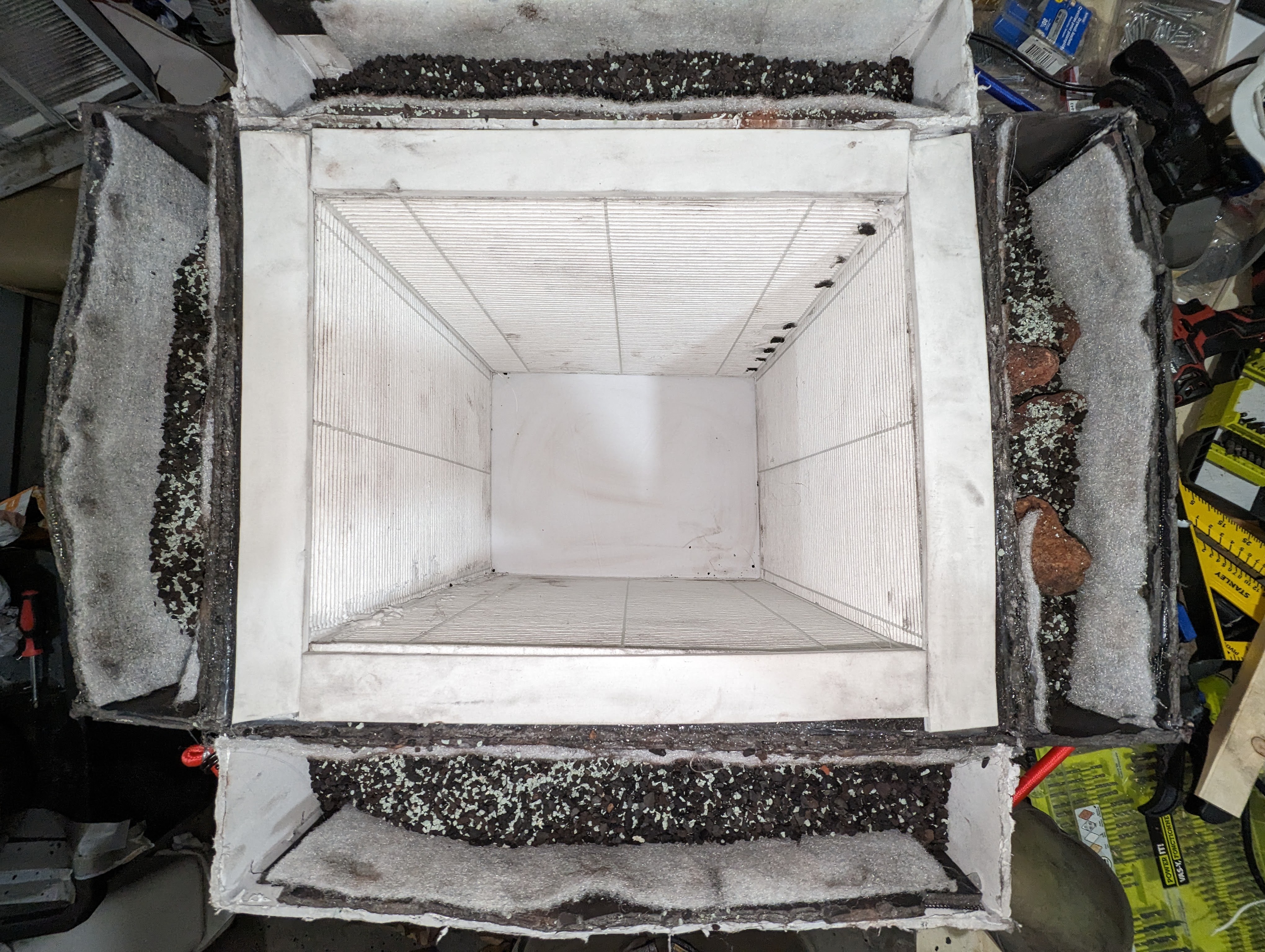
Wood frame construction:
Then, I (with the help of my dad) constructed the frame for the air purifier using plywood from Home Depot. I used Home Depot’s wood cutting service to cut the plywood. We joined the wood pieces together using wood glue, nails, and screws, to create a rectangular frame to house the inner components in it. Then, we joined the parts of the frame together using screws, wood glue, and nails. I sealed the box (air purifier housing) using silicon calk and weatherstripping. In the bottom, we also made a 3-inch empty air chamber where air will enter in from the wet scrubber. On the top of this air chamber, we drilled holes where the air would enter the pre-filter/activated charcoal, zeolite, and lava rock filters. I placed a piece of plywood over the HEPA filter assembly (with hole cut for the clean air) and sealed the corners of the plywood to the wooden frame. Afterwards, I applied weatherstripping on this air outlet hole and adjusted the blower fan over it. The blower fan will pull the air through the air filters. During construction and after completion of the wood frame construction, I also tested the air flow to confirm that the air is flowing through the filters.
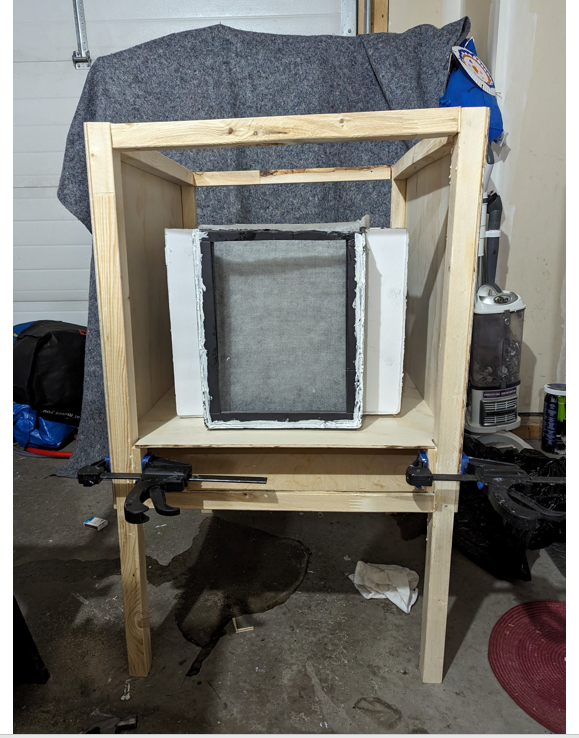
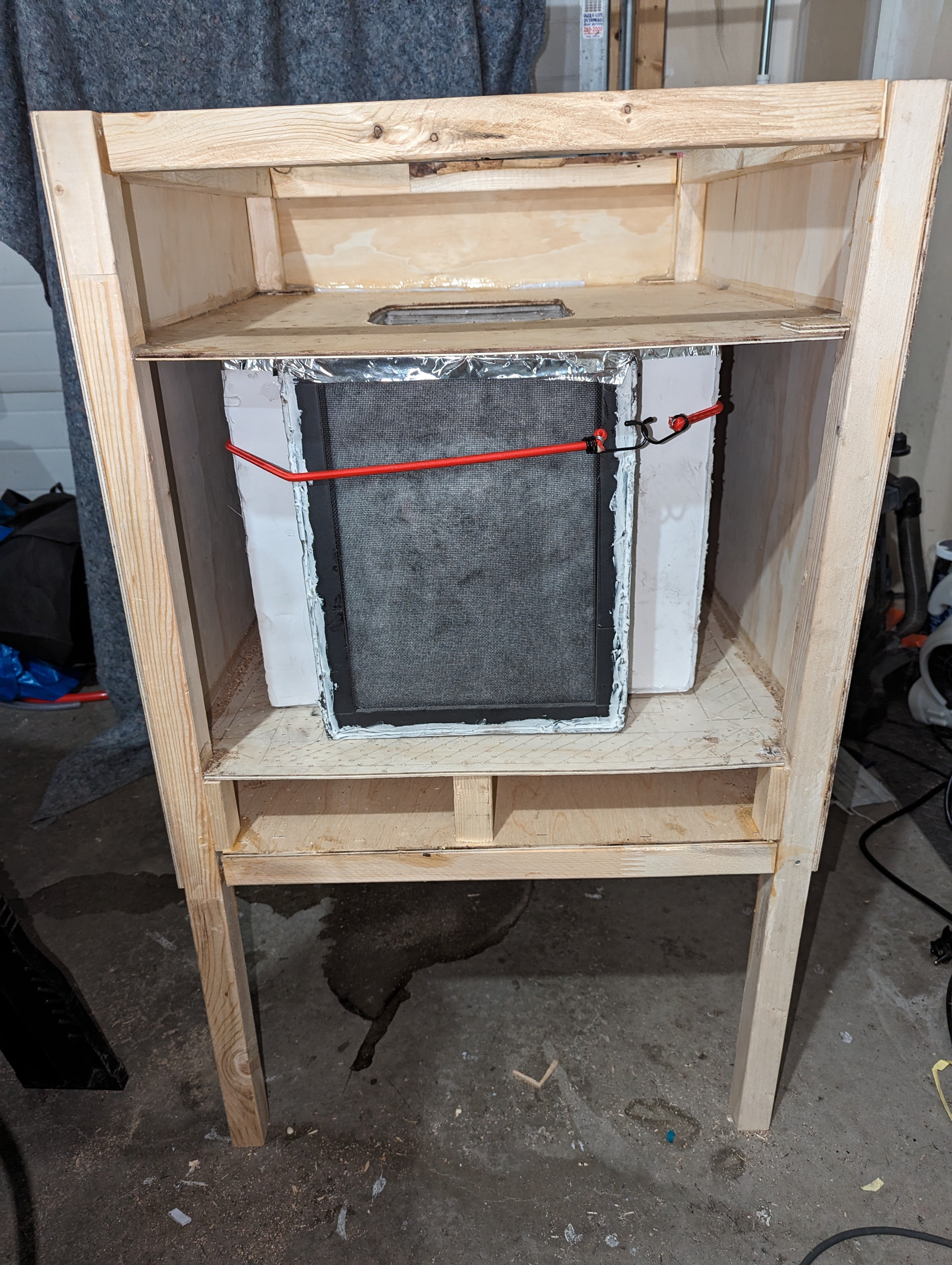
Wet scrubber:
An aquarium air pump & stones, air pipe was used to make it. I made a hole on the ceiling of the water container into which air pipes were placed. These pipes were pulled out from the bottle mouth and air stones were connected to the pipes. The air stones were placed back into the bottle. A 3-inch air duct was connected from the bottle mouth to the bottom of the air filter.
Air purification testing:
I intended to test this system inside a tent in our living room. However, the air purifier was so heavy that we could not move it safely. Therefore, we decided to test it in the garage. I burned a 3-inch incense stick and started the air pump and blower fan. Afterwards, I sprayed two pumps of 2% formalin and 5 pumps of hair spray in the garage. The air quality monitors were also switched on. Afterwards, I quickly came out of the garage and closed the door. I tested for 1 hour. I measured the air quality, PM 2.5 & PM10 numbers and their concentrations (dependent variables) in the air. In addition, I will also measure TVOCs and formaldehyde. The controlled variables were incense sticks, room size, fan speed, and amount of water and oil in the wet scrubber.
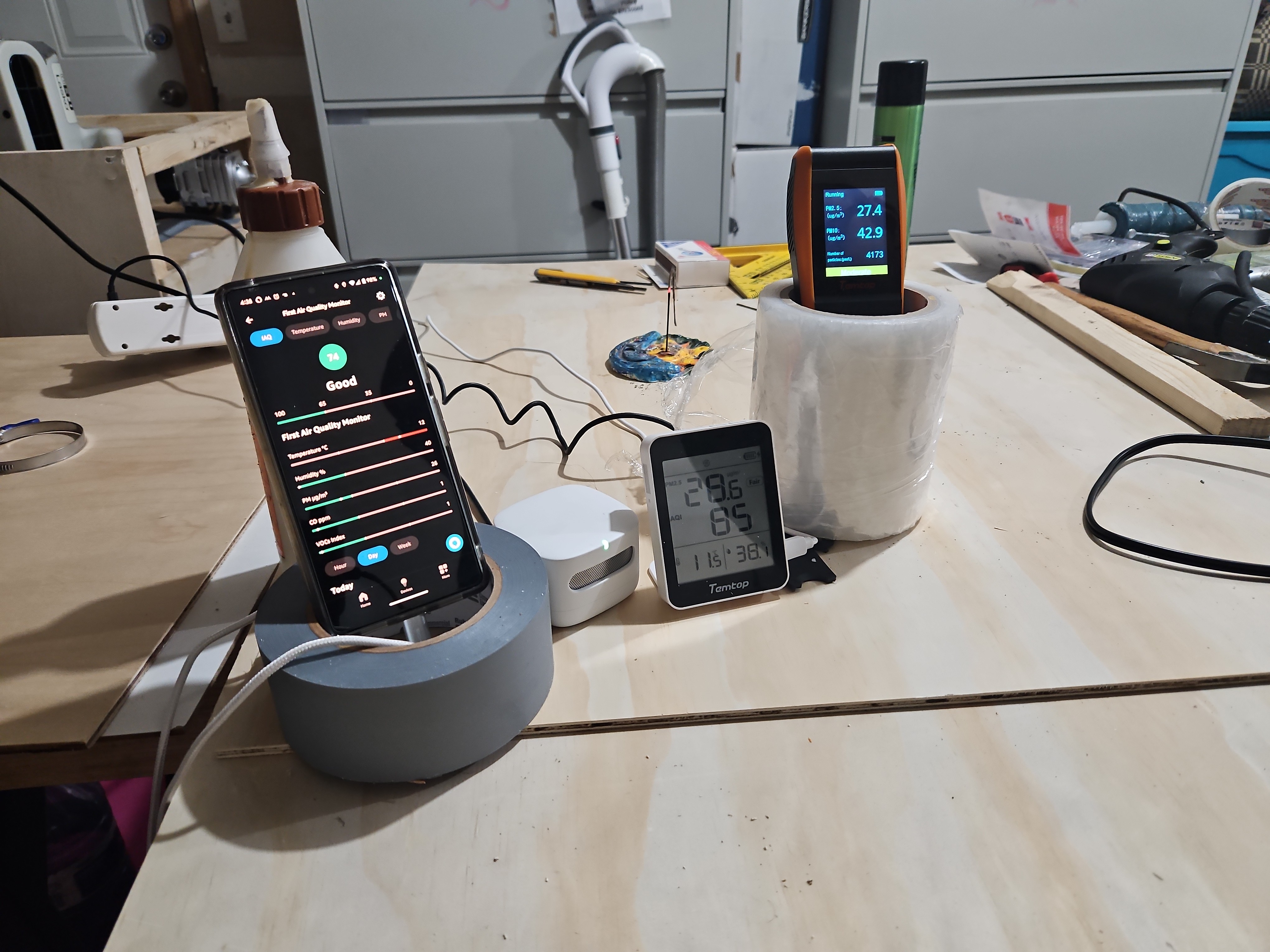
Wet scrubber testing:
I collected water and oil samples. These samples will be sent to the AGAT laboratories for PAH capture testing. The AGAT laboratories graciously agreed to perform these tests. I will also measure the pH and total dissolved solids in the water. The results of this test will be shown in May If I am selected for the presentation.
Analysis
AQI:
The air quality index to moderate levels (between 50-100) after burninng the incense. However, after running the air purifier (n=3), the AQI came back to good levels within 30 minutes of running the air purifier.
Total number of particles:
The total number of particles/L of air increased after burning incense, which reduced after running the purifier for 60 minutes.
PM 2.5:
The total concentration of PM2.5 (μg/m3) in air increased after burning incense, which reduced after running the purifier for 60 minutes.
PM10:
The total concentration of PM10 (μg/m3) in air increased after burning incense, which reduced after running the purifier for 60 minutes.
Formaldehyde:
Unhealthy levels were not generated after 2% formalin spray.
TVOCs:
Unhealthy levels were not generated after hair spray.
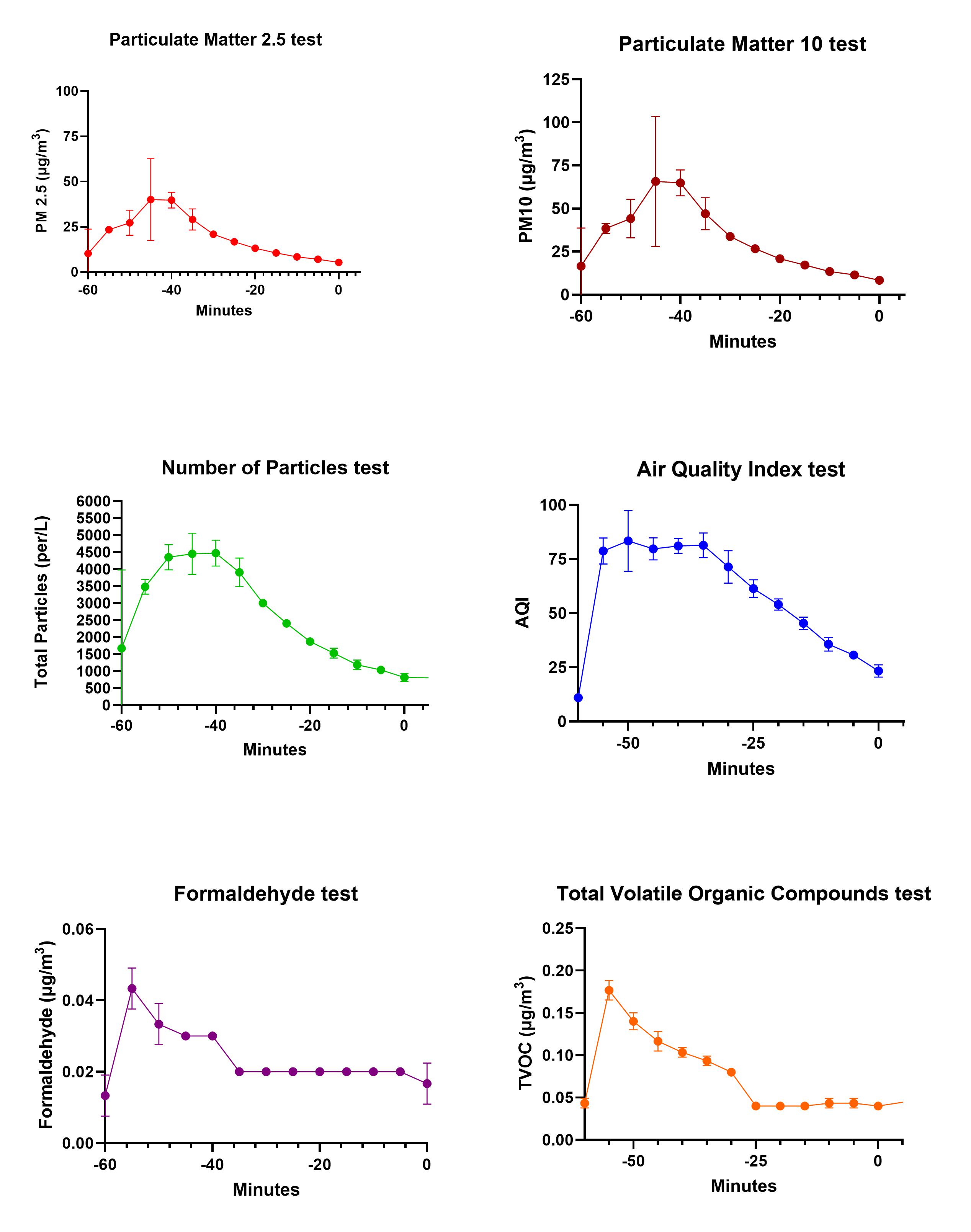
I downloaded data from Air Quality Monitors and entered the GraphPad software. Unfortunately, the incense stick did not burn well in the control group. I would need to repeat the control groups. Due to this, I could not compare the means of the test and control groups. I would have used an unpaired t-test to compare the means of two groups using their mean, SD, n values.
Unfortunately, the control inscence stick did not burn.
Conclusion
- The levels of air pollutants generated were in moderate levels. This could be due to the reason that experiments took place in the garage that is not sealed well.
- The results indicates a trend that the air purifier is able to purify the air of high levels of the PM. However, due to the failure of incense stick in control group, the results are not conclusive. I would need to repeat the control group experiment.
Citations
Air pollution. (n.d.). Retrieved March 31, 2023, from https://www.who.int/health-topics/air-pollution
Canada, E. and C. C. (2023, June 29). Wildfire smoke, air quality and your health [Education and awareness]. https://www.canada.ca/en/environment-climate-change/services/air-quality-health-index/wildfire-smoke.html
Canada, H. (2022, January 21). Outdoor air pollution and health: Overview [Guidance]. https://www.canada.ca/en/health-canada/services/air-quality/outdoor-pollution-health.html
CBC ·, K. N. ·. (2023, July 6). Wildfire fighters work in heavy smoke, and in Canada have little protection | CBC News. CBC. https://www.cbc.ca/news/canada/wildfire-fighters-smoke-protection-1.6897879
Nicholson, K. (2023, July 6). Wildfire fighters work in heavy smoke, and in Canada have little protection. CBC News. https://www.cbc.ca/news/canada/wildfire-fighters-smoke-protection-1.6897879
Rosenthal, J. (2020, November 4). How to Improve the Efficiency of the Corsi-Rosenthal Box Air Cleaner. Tex-Air Filters. https://www.texairfilters.com/how-to-improve-the-efficiency-of-the-box-fan-and-merv-13-filter-air-cleaner/
Acknowledgement
- Ms. Mandy Ho and Ms. Emilie Ontko, Balmoral School
- Ms. Kelly Howard & Ms. Joanne Wudrich, AGAT Laboratories
- Shapr3D software
- GraphPad
- My parents and little sister

